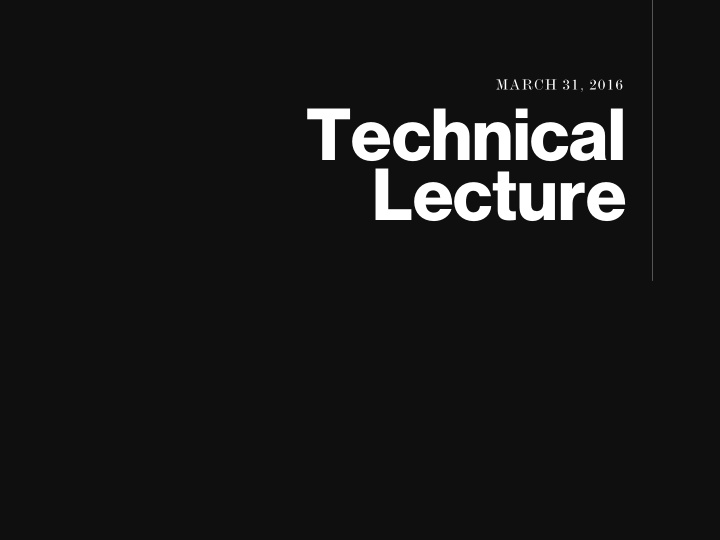



MARCH 31, 2016 Technical Lecture
Designing the Web How is data transmitted across networks? What is the di ff erence between the internet and the worldwide web.
What is the internet? “A network of networks” not a single entity with a single owner; a single entity with a single owner; no comprises a hierarchy of individual comprises a hierarchy of individual networks that have been connected networks that have been connected to one another. to one another.
Design Factors 1. The network would not have a central controlling computer. 2. The network should be able to deliver information between any two computers on the network even if some of the machines in the network had failed.
Datagram When When data, data, such such as as a a pictur picture, e, movie movie or or a a document document is is sent ent ov over er the the int internet, ernet, it it is is not not sent ent as as a a single single chunk. chunk. Ins Instead ead it it is is split split up up int into o small, small, unif uniformly ormly siz sized ed block blocks s called alled da ams , , als also o sometimes ometimes called alled datagr tagrams pack packets. ts.
It’s It’s actually actually possible possible to to see see these these datagrams in action, often with h surprising results. surprising results. http://www.monitis.com/traceroute/
Websites that receive heavy usage from a particular location might be cached locally ; that is to say, copies of the website’s data might be temporarily stored on a computer closer to the location from which the information is being accessed.
Why we internet standards? As you’ve learned, when you send data over the internet it is sent across several hierarchies of networks, using di ff erent technologies from many di ff erent providers and operated by di ff erent organizations.
TCP (Transmission Control Protocol) The TCP protocol is responsible for ensuring data can be sent reliably over the internet. It works through a number of software ports that act to keep data separate on the same computer – so it is possible to browse a web page, collect email and listen to streaming music at the same time.
Common TCP Port Numbers port 20 – File Transfer Protocol (FTP) for sending and receiving files port 22 – Secure Shell (SSH) for secure logins to computers port 25 – Simple Mail Transfer Protocol (SMTP) for sending email port 80 – HyperText Transfer Protocol (HTTP) for browsing web pages
IP (Internet Protocol) The Internet Protocol does the hard work of actually moving data across the internet. IP is only concerned with moving data, it doesn’t actually check that data actually arrives (that’s handled by TCP).
IPv4 Most familiar form of IP address consisting of four digits, each ranging from 0 to 255, separated by full stops (periods) in the form 192.168.0.1. IPv4 has long underpinned the internet although it is now in urgent need of replacement due to exhausting available addresses IPv6 A replacement for IPv4 originally outlined in 1998 to accommodate the increasing demand for IP numbers as more people and devices were connected to the internet. IPv6 can support a theoretical 3.4 × 10 38 devices meaning it is suitable for any conceivable demand.
The internet is not the The internet is not the World-Wide Web! World-Wide Web! We’ve all done it. We’ve been browsing a website and said ‘I’m on the internet’”.
The World Wide Web is nothing more than the part of the internet that can be accessed through the HyperText Transfer Protocol (HTTP) . HTTP allows two computers to exchange information as a series of requests and responses
The World Wide Web is an example of hypertext – documents joined together using links. Every time you click on a link, HTTP is used to request a new page from a web server using TCP port 80.
The World Wide Web was designed from the very start to be an open environment which encouraged people to set up their own web servers and to write web pages.
The computer language used to format web documents is HyperText Mark-up Language (HTML)
When writing HTML, you add "tags" to create the structure. These tags tell the browser how to display the text or graphics in the document.
JavaScript is a programming language used to make web pages interactive
HTML tags create objects; JavaScript lets you manipulate those objects.
AJAX (Asynchronous JavaScript and XML) loads data from the server without a browser page refresh.
That is, your javascript can send asynchronous requests then use the results of those requests to modify its page
The only part of AJAX that you need is the XMLHttpRequest object from javascript. This is used to load and reload small part of your html as a div or any other tags.
jQuery simplifies HTML document traversing, event handling, animating, and AJAX interactions for Rapid Web Development.
JSON (JavaScript Object Notation) is a way to store information in an organized, easy-to-access manner.
Is Javascript limited to front- end develpment?
Node.js is built on Google Chrome’s JavaScript Runtime engine called V8. V8 could be used to handle the role of a server side language while taking a d v a n t a g e o f J a v a s c r i p t ’s asynchronicity.
Recommend
More recommend